The Sinking of the Andrea Doria
Cascading Catastrophies
by Tom Seymour
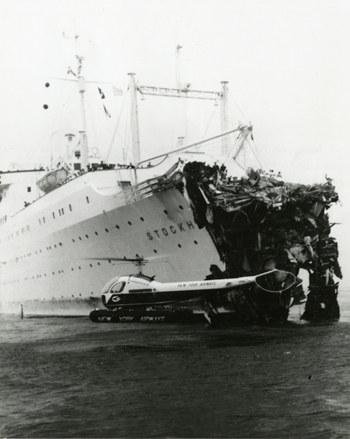
A helicopter hovers close to the damaged bow of the Swedish liner Stockholm as the vessel limps into New York Harbor, July 27, 1956. The ship collided with the Andrea Doria two days earlier 45 miles southeast of Nantucket Island, MA. USCG photo.
In the years immediately following World War II, Italy had a lot of catching up to do. It needed to show the world that it once again was a major player on the world stage. One way Italy went about that was to launch a new luxury liner.
And so the Andrea Doria was built. Named after a Genoese admiral, Andrea Doria, the 697-foot ship had a crew of 500, a tonnage of 29,100 and the capacity to carry 1,200 passengers. Andrea Doria made her maiden voyage on January 14, 1953.
Andrea Doria was not the swiftest ocean liner of its time, rather its reputation was built upon it being the most beautiful and extravagant. For instance, it boasted of three swimming pools, one for each passenger class. Paintings, murals and tapestries festooned its walls. Attractions also included a full-size, bronze statue of the ship’s namesake.
In addition to its luxury fittings, the vessel was equipped with two radar screens, something new for ocean liners. The hull was comprised of 11 watertight compartments, two of which could entirely fill with water without putting the ship in danger of sinking. Also, the ship’s lifeboats were able to accommodate all passengers. These were 16 steel lifeboats, 8 fastened to each side of the ship. Additionally, she carried two 58-person launches and two 70-person motorboats equipped with radio transmitters and two 146-person, manually propelled boats.
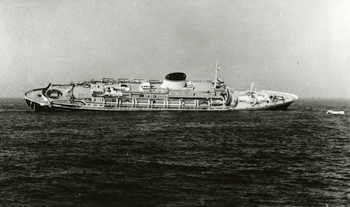
SS Andrea Doria listing after a collision with the Stockholm on July 24, 1956. The ship’s three swimming pools visible on the after decks. Port lifeboats were too high to launch. One of the starboard lifeboats, too low to board, adrift at right. USCG photo.
Finally, Andrea Doria was equipped with a modern, early warning radar system. For all practical purposes, it seemed as though Andrea Doria was the ship to be on. But this feeling of safety was an illusion, since the vessel had serious design flaws.
Specifically, Andrea Doria was prone to listing when struck by any kind of major force. Indeed, this came to light during the maiden voyage, when the ship struck a huge wave off of Nantucket Island. This caused Andrea Doria to list 28 degrees. Unfortunately, the watertight compartment’s bulkheads only extended to the top of Deck A. Any list greater than 20 degrees would cause water from a flooded watertight compartment to spill over into adjoining compartments. Even worse, because of the vessel’s design, lifeboats could not be launched if the vessel listed more than 15 degrees. The vessel survived this episode, but instead of using it as a learning event, everything continued as per usual. No rules were adopted that might have averted future tragedy.
Fatal Voyage
The feeling of safety
was an illusion,
since the vessel had
serious design flaws.
After completing 100 transatlantic crossings, passengers and crew embarked upon the 101st crossing with full confidence that this, too, would be a safe and enjoyable voyage. Andrea Doria left her Italian home port of Genoa on July 17, 1956, with a crew of 572 and a complement of 1,134 passengers. The passengers ranged from casual vacationers, business people, Italian immigrants and even Hollywood stars. And so, after stops at three different Mediterranean ports, the vessel entered the Atlantic Ocean on her 9-day trip to the Port of New York.
By July 25, Andrea Doria found herself in the busy sea lanes off of the Unites States Northeast coast. Also on July 25, the Swedish passenger ship Stockholm left the Port of New York en route to Gothenburg, Sweden.
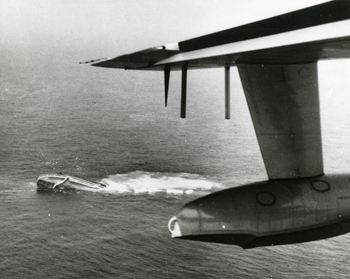
Rolling to starboard as the “watertight” compartments filled with water. Port life boats securely in place for the ride down. Many survivors spent the night in life boats in thick fog. USCG photo.
By 10:30 p.m. of that same day, the two vessels Andrea Doria and Stockholm were on a collision course with each other. Andrea Doria was sailing through a thick fog. This troubled Andrea Doria’s captain Calamai, who feared being late for his appointed arrival in the port of New York.
So despite the fogbank that had engulfed his vessel, Calamai only reduced his speed by a slight bit so as to arrive on time. In doing so, Captain Calamai was deliberately ignoring navigation rules. These rules stated that during times of limited visibility, vessels must reduce speed to a stopping distance within half the distance of visibility. In Andrea Doria’s case, this would have meant coming to a complete stop because of the pea-soup fog.
This was the first of a number of calamitous errors.
As the two vessels
drew closer to each other
the vessels misinterpreted
each other’s course.
Captain Calamai did activate the ship’s fog-warning whistle and he closed the watertight doors. But this amounted to too little, too late.
At this point, the Stockholm’s captain was unaware of the fogbank just ahead of him. As both vessels continued on their chosen paths, neither knew the danger they were facing. Soon, though, radar indicated the presence of the other ship to both captains. Strangely, neither vessel attempted to make radio contact with the other. The Andrea Doria also violated standard radar procedure. She did not use her plotting equipment to establish the speed, course and position of the other vessel. This breach of protocol meant that Andrea Doria had no knowledge of the approaching vessel’s speed or course.
Additionally, Andrea Doria failed to adhere to the International Regulations for Preventing Collisions at Sea. These dictated that a ship must turn to starboard (right) when meeting another vessel head-on at sea. So as Stockholm turned to starboard, Andrea Doria turned to port (left). This set the stage for a collision and by the time Andrea Doria saw her error, it was too late. The die was cast for tragedy.
As the two vessels drew closer to each other with a combined speed of 40 knots, the vessels misinterpreted each other’s course. Had they made radio communication, collision might have been avoided.
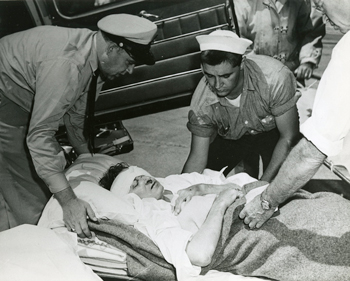
Logan Airport, Boston. Patient one of the injured in the collision being transported to the U.S. Public Health Service Hospital in Brighton, MA. USCG photo.
By the time visual contact was possible, collision was inevitable. Just before the two vessels collided, Stockholm had turned sharply to the right and was reversing her propellers in an effort to stop. But it was too late. Andrea Doria never slowed down as she made a sharp turn to port, in hopes of outrunning the collision. Consequently, at about 11:10 p.m., the vessels collided, Stockholm smashing in the side of Andrea Doria.
And now, another error on the part of Andrea Doria’s captain led to the actual sinking of the vessel. The Italian line’s rule stated that the half-empty fuel tanks were supposed to be pumped full of seawater as ballast. That would have helped to stabilize the ship in the event of a collision. But to do so would have cost more money during the re-fueling process and as a cost-saving measure, the captain declined to follow stated procedure. This was another fatal error.
Now, with the ship’s side stove in, seawater flowed in through a huge gash that penetrated 40 feet into the region of the watertight compartments and fuel tanks. The Stockholm’s bow took out just one of Andrea Doria’s watertight compartments, but it also ruptured five fuel tanks that were situated below the waterline on the starboard side. These immediately filled with seawater.
By the time visual
contact was possible,
collision was inevitable.
At the same time, the five empty fuel tanks on the port side were filled with air, which caused them to float, thus further contributing to the list. Had these empty tanks been filled with seawater, as ballast, something that should have occurred but didn’t, it is likely that the ship would not have developed such a dangerous list.
Even worse, the severe list prevented the crew from pumping seawater into the ship’s port-side fuel tanks and thus right the vessel. Also, the list prevented the launching of the port-side lifeboats.
Fatal errors were not confined to Andrea Doria’s captain and crew. The navigating officer on Stockholm made a serious error in interpreting his radar reading. He thought the radar was on a 15-mile setting when in fact, it was only on a 5-mile setting. This inaccuracy led him to assume that the two ships were much further apart than they really were. Also, the navigator did not forward his radar information to his captain, as was required by regulations.
As if all that weren’t bad enough for Andrea Doria, the collision tore open an access tunnel running from the generator room to a smaller room at the forward end of the tank compartment, a room that held controls for the pumps. This tunnel ran through the bulkhead that separated the two compartments, but unfortunately, there was no watertight door. Consequently, the generator room flooded quickly, shutting down electricity to the ship.
In addition to the lifeboats on the port side being so high in the air because of the pronounced list, being unavailable, there were problems with lifeboats on the starboard side. It was now impossible to launch filled lifeboats from the Promenade Deck, where they could be easily lowered into the water. Instead, it was now necessary to lower empty lifeboats and then find a way to get people in them.
The crew was compelled to resort to ropes and something called Jacob’s ladders, rope ladders with wooden rungs. Because stampeding passengers were always a major concern, Captain Calamai did not give the order to abandon ship until assistance arrived in the form of boats from other ships. Instead, passengers were instructed to don their lifejackets and then to proceed to designated muster stations.
Post-Collision
Immediately after the collision, both vessels sent out radio distress calls. Amazingly, this was the first time the two vessels learned each other’s identities. These distress calls were picked up by various Coast Guard stations up and down the northeastern coast. And shortly after that, the news went out over the airways to the general public that two big ocean liners had experienced a collision at sea.
The SOS sent out by Andrea Doria read, “SOS DE ICEH (this is Andrea Doria) SOS HERE AT 0320 GMT LAT. 40.30 N 69.53 W NEED IMMEDIATE ASSISTANCE.” It was plain that nothing available to captain and crew would have any effect upon righting the ship and that she was most certainly doomed.
Seawater flowed in
through a huge gash
that penetrated 40 feet
into the hull.
Conditions aboard Stockholm were better than those on Andrea Doria, although that wasn’t evident by looking at the ship’s bow, since about 30 feet of bow was crumpled and ripped away. At first it looked grim for Stockholm because the vessel was extremely low in the bow. But after the crew emptied the freshwater tanks, the bow then raised to within 4 inches of normal.
Also, while damage to the bow was impressive, the damage did not extend aft beyond the bulkhead and the first two watertight compartments. And so while having sustained grievous damage, Stockholm was pronounced stable, with no immediate danger of sinking.
Forty-six people died on Andrea Doria as a result of the collision and five persons died on Stockholm. In all, a total of 1,660 passengers and crew were rescued and these all survived.
One reason for the great number of people being rescued was that a large number of other vessels in the near area heard and responded to the distress calls. This was highly fortuitous, since the remaining, launchable lifeboats were only capable of carrying 1,000 persons. So according to History, Andrea Doria radioed the following message: “Need lifeboats–as many as possible–can’t use our lifeboats.”
Also according to History, because the collision occurred in a busy shipping lane, help was quick in arriving. The Stockholm was the first to send boats to rescue passengers and soon after, a freighter, Cape Ann, arrived on the scene sometime around 12:30 a.m. and began rescuing passengers. Very soon after, two US naval vessels arrived at the scene, but even with these, lifeboats were limited.
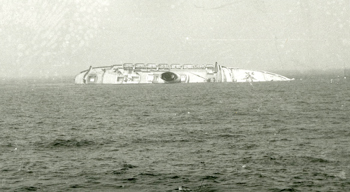
The last act in the sinking of Andrea Doria occurred at 10:09 a.m. on July 26, 1956. Just before going stern up when the ship dove to the bottom. Coast Guard sea plane in the foreground circling the event below. USCG photo.
And then, about 12:30 a.m. a giant French liner, the Lle de France, managed to place herself alongside Andrea Doria, whereupon it turned on its floodlights and began rescuing people. Rescue efforts were fruitful and five hours later, at 5:30 a.m., most of Andrea Doria’s survivors were safe aboard the Ile de France, Stockholm, and four other vessels.
At this point, Captain Calamai considered having Andrea Doria towed to shallow water, where she might still have a chance of not becoming a total loss. But closer examination showed that the ship was doomed and there was no possibility of saving her.
As the remaining crew were boarding the last lifeboat, Captain Calamai indicated that he would not accompany them and it appeared that he was prepared to go down with his ship. But his crew persisted and the captain finally boarded the lifeboat.
Andrea Doria began sinking at 9:45 a.m. and 15 minutes later, was leaning on its side. Then the starboard side went under the waves. Those viewing from other vessels could see the three swimming pools filling with water.
Next, the bow became submerged, which caused the stern to rise, exposing the port propeller and shaft. Finally, the port side dipped beneath the surface. With this, a number of the remaining lifeboats were ripped from their divits and floated upside-down, all in a line.
The last act in the sinking of Andrea Doria occurred at 10:09 a.m. on July 26, 1956, when the great ship pitched, bow-first, into the icy Atlantic.
Harry A. Trask, of the Boston Traveler newspaper, viewed the scene from the air and took a series of photographs of Andrea Doria capsizing and sinking. For these, Trask won a Pulitzer Prize in 1957.
After the collision, hearings were held in New York City. Numerous attorneys represented victims and their families. Ships officers from both vessels gave lengthy testimonies. Then, after several months, the hearings ended due to an out-of-court settlement.
The Andrea Doria–Stockholm collision resulted in a number of rule changes for vessels at sea. Because radar was badly used, shipping lines were required to institute better and more extensive training on radar equipment. In addition to that, approaching ships were now required to contact each other by radio, something that, if Andrea Doria and Stockholm had done, might have averted the great tragedy.
Although the sinking of Andrea Doria occurred 63 years ago, the event is not forgotten. Survivors and families have regular reunions. Books and videos abound on the subject. And rightly so, since the entire sequence of events stands as something that must be remembered as long as ships take to the waves.
See additional photos here.
